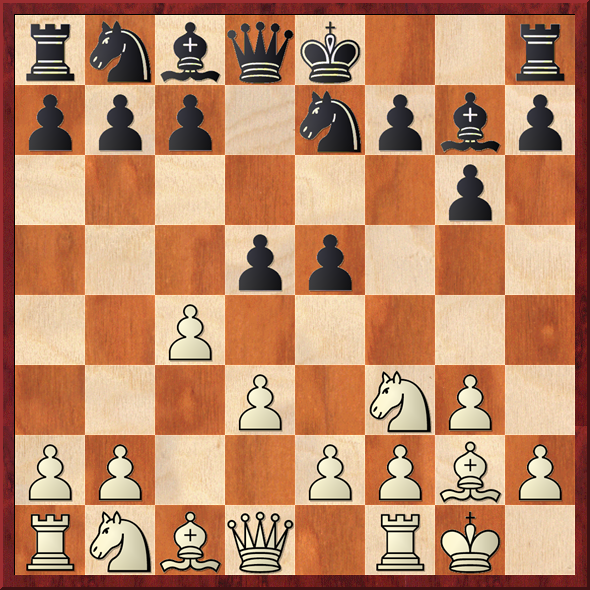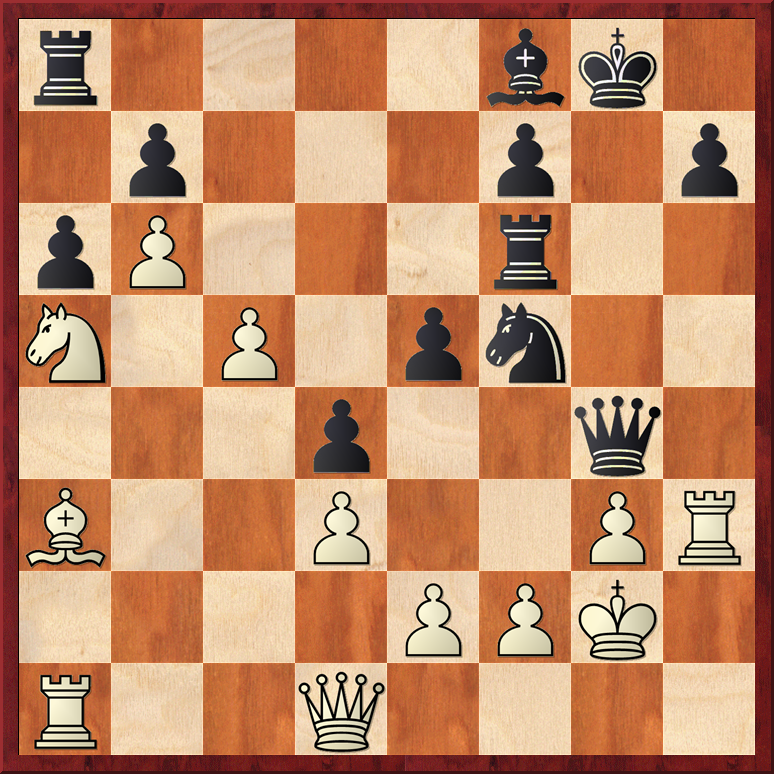Last time I looked at my round 5 game from a recent tournament at the Marshall Chess Club, and this time I'll do a similar deep dive into the game I played in round 4 of the same event.
Paciorkowski, Lev (2415) - Meduri, Aakaash (2213)
Marshall FIDE Premier, New York, NY (Rd. 4)
G/90+30
My opponent is a master-level player who is a few years older than me. I wanted to avoid a theoretical discussion this game, so I played the classic Nf3-g3-Bg2 as white.
1.Nf3 d5 This is the most principled response, in my opinion. 2.g3 g6 3.Bg2 Bg7 4.0-0 (4.d4 would transpose into lines of the symmetrical Fianchetto Grunfeld, which was a bit too dry for my taste this game) 4. ... e5 (D)
Black has played in the most direct and principled fashion, seizing full control of the center. This now is likely to transpose to some sort of reversed KID or Benoni. I did not know any specific theory about this variation for either side and after a few more moves it seemed like my opponent was also out of his book.
5.d3 (The move 5.c4!? is an alternative, when 5. ... dxc4 6.Qa4+ c6 7.Qxc4 Ne7 leads to a roughly equal position, resembling a reversed Sicilian. The move I actually played is the main line.) 5. ... Ne7 (This is also the main line for black - the knight cannot develop to f6. Alternatively, 5. ... Nc6 6.Nbd2 Nf6 7.e4 0-0 8.c3 would lead to a reversed Pirc.) 6.c4 (D)
Perhaps the first small critical moment of the opening. Black has to decide if he wants to leave the tension or release it, either by taking on c4 or advancing to d4. I'll note that my 6.c4 is only the third most common move for white, behind 6.e4 and 6.Nbd2; however, I like the move I played because it can tempt black into making an inaccurate decision.
Probably the best continuation for black is to play the symmetrical position with 6. ... dxc4 7.dxc4 0-0 8.Nc3 (D), reaching the position below:
Is this not just completely equal? Well, black does have better center control, but white has a slight lead in development, a fully open Bg2 compared to black's Bg7, and the e5 pawn can also be a target. After the most normal move for black 8. ... Nbc6, my engine suggests the interesting move 9.Rb1!?, clearly with the idea of b2-b4-b5. The most obvious reply for black is 9. ... Bf5, which looks good for black, but the idea for white is then to play 10.e4 (we get this move for free now) 10. ... Bg4 11.Qxd8 (apparently a novelty; there was one Giri-So game from 2020 where white played 11.h3 instead) 11. ... Raxd8 12.Nd5, when at least black has some small problems to figure out. This resembles the exchange variation of the KID.
Alternatively, in response to 9.Rb1!? black could also play 9. ... a5!?, but then after just 10.b3 black anyway has nothing better to do than 10. ... Bf5 11.e4 Bg4 and we will reach the same kind of position.
One last point I will mention is that after 9.Rb1!?, the move 9. ... Be6?! would be incorrect, because white can play 10.b3! (which would not have been possible with a rook on a1 because of the ...e4 push) and blunt out the bishop. Then, trying to gain central space with 10. ... h6!? 11.Ba3 f5 would be well-met with 12.e4! +/=, and black has some minor problems to solve.
Anyway, in the actual game, my opponent played 6. ... d4?! (D), which is tempting, but actually slightly incorrect in this position - although I did not react in the most precise way.
What white should do at this point is immediately pounce on the queenside with 7.b4!. I did consider this, but thought somehow I'd be giving away too many squares after 7. ... a5!? 8.b5!, when black later will put a piece on c5. However, it isn't so simple. After the further 8. ... 0-0 9.a4, the attempt to occupy c5 with 9. ... Nd7 is stopped cold simply by 10.Ba3.
In reality, after 7.b4! a5!? 8.b5! 0-0 9.a4 black should simply play 9. ... c5 to stake out some queenside space. Then white can play for the e2-e3 break in elegant fashion with 10.Ra2 Nd7 11.e3 dxe3 (strategically forced; black cannot allow exd4 when he has to either open the b8-h2 diagonal or allow white a 3-2 majority on the queenside) 12.fxe3! e4! (left to his own devices, white will play Nc3 and e3-e4, and later plunk a knight into d5) 13.dxe4 +/= (D)
This was actually all seen in a 2018 rapid game between Oparin and Korobov. Black ended up winning the game, but white is actually quite a bit better here because we can prepare Nc3-d5 quickly. In fact, the only reason black is not just outright much worse is because he can organize counterplay against c4 (which he must do immediately): 13. ... Nb6! 14.Qb3 Be6. Then white should play 15.Nbd2, and later Bb2 to trade dark squared bishops and later we can go for e4-e5 and Nd2-e4-d6.
After 7.b4!, if black just ignores white's queenside expansion with 7. ... 0-0 then white will anyway keep going with 8.a4 Nd7 9.b5 +/=, and black will be hard-pressed to prevent a pawn break over there eventually. The conclusion is that 6. ... d4?! is inaccurate and white is better after 7.b4!
In the actual game, I didn't appreciate the urgency and instead played 7.Nbd2?!, and here black should play 7. ... a5!, to prevent my expansion. Instead though, he returned the favor to me with 7. ... 0-0?! and now I finally got back on track with 8.b4 (D)
So we are entering the middlegame, and white is slightly better - this is basically a dream Benoni where we have already gotten the queenside rolling. Black should probably go with the 8. ... a5 9.b5 c5 plan again, but instead he did something which I thought was a little strange: 8. ... c6 9.Nb3!? (9.a4! and 10.b5 is the most direct). 9. ... Bg4?! 10.a4 Qc8. Here I correctly judged that black's intended plan was not good and simply continued 11.Ba3 Bh3 12.Bxh3! Qxh3 13.b5 Re8 (D)
White now has a rather significant advantage. Black is not going to checkmate me with just a queen (although he certainly tried later...), and what has actually happened is that black spent 4 moves just to trade off one piece and allowed me to finish development. I sensed an opportunity to pounce and misplace black's pieces, and there followed 14.Ng5 Qh5 15.Ne4 Nf5. Now black's queen is a big tactical liability, and the queenside is poorly defended. Next came 16.Bc1!? (maybe not best, but not bad - it opens up the option of playing f2-f3, when black's queen actually must be careful not to get trapped somehow) 16. ... Nd7 17.Na5 cxb5 18.axb5 a6 (D)
Black is not losing material yet, but he is fighting a losing battle on the queenside. Here I thought about 19.Nxb7 axb5 20.Rxa8 Rxa8 21.cxb5 Rb8, but somehow didn't appreciate the strength of the simple 22.Qc2!, when white is just completely winning.
19.b6 This is also strong. 19. ... Re6 20.c5 Bf8 21.Ba3?! White is still better after this, but it allows some unnecessary counterplay. Instead, it is fairly simple to calculate that 21.Nxb7 Rb8 22.Qc2! is just winning for white: black cannot hold things together after 22. ... Rxb7 23.c6 Rb8 24.cxd7 Rexb6 25.Qc7 +-.
21. ... g5! (D)
This strong move caught me completely by surprise - I have actually noticed that I often miss these sorts of pawn moves which allow a lateral major piece maneuver. In fact, I do miss lateral major piece maneuvers in general more frequently than I should...
Luckily, I am still in control and with some accurate moves I could defend against the attack. The queenside battle is still won - b7 can be captured at any moment. 22.Kg2 g4 23.Rh1 Nf6 24.Nxf6+ Rxf6 25.h4 gxh3+ 26.Rxh3 Qg4? (D) (26. ... Qg6 would have kept the game going)
It is now my opponent's turn to overlook an important detail. 27.e4! This tactical pattern is also commonly overlooked, even by strong players. Black must either sacrifice a piece for a futile attack, or trade queens and lose the b7 pawn. Understandably, he chose the former, and the rest was fairly easy, even in mild time pressure (after this move I had 6 minutes left to his 13).
27. ... Ne3+ 28.fxe3 Rf2+ 29.Kxf2 Qxh3 30.Qh1 dxe3+ 31.Ke2 Qd7 32.c6 Qd4 33.cxb7 Rd8 34.Qb1 Qd7 35.Bxf8 Qg4+ 36.Kxe3 Qxg3+ 37.Kd2 Qf2+ 38.Kc3 Qd4+ 39.Kb3 Kxf8 (39. ... Qxb6+ 40.Bb4) 40.Nc4 Qd7 41.Ra5 Qxb7 42.Rxe5 Qc6 43.Kc2 Rd4 44.Qb4+ Kg7 45.Qc3 Qa4+ 46.Kc1 1-0
Another instructive game, with plenty to be learned from the opening. Perhaps next time I will look at another game of mine from this event.










No comments:
Post a Comment